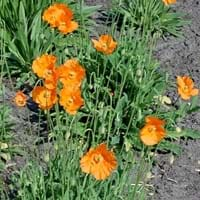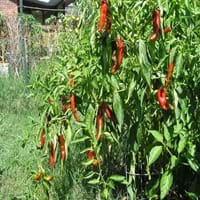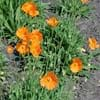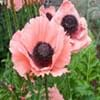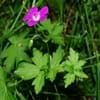Life Span
Perennial
Perennial
Type
Flowering Plants
Vegetable
Origin
Northern Africa, Morocco
Mexico, Central America, South America
Types
Not Available
Poblano, Thai pepper, Cayenne pepper
Number of Varieties
Not Available
Habitat
gardens, Grassland, Roadsides, tropical environments
Cultivated Beds
USDA Hardiness Zone
6-8
10-11
Sunset Zone
2b, 3a, 3b, 4, 5, 6, 7, 8, 9, 14, 15, 16, 17, 18, 19, 20, 21, 22, 23, 24
A1, A2, A3, H1, H2, 1a, 1b, 2a, 2b, 3a, 3b, 4, 5, 6, 7, 8, 9, 10, 11, 12, 13, 14, 15, 16, 17, 18, 19, 20, 21, 22, 23, 24
Habit
Clump-Forming
Oval or Rounded
Flower Color
Orange
White
Flower Color Modifier
Bicolor
Bicolor
Fruit Color
Not Available
Red, Green, Crimson
Leaf Color in Spring
Light Green, Gray Green
Pale Green
Leaf Color in Summer
Light Green, Gray Green
Green
Leaf Color in Fall
Light Green, Gray Green
Green, Black
Leaf Color in Winter
Not Available
Green
Leaf Shape
Egg-shaped
Cordate
Plant Season
Spring, Summer
Spring, Summer, Fall
Sunlight
Full Sun, Partial Sun
Full Sun
Type of Soil
Loam, Sand
Loam
The pH of Soil
Neutral, Alkaline
Neutral
Soil Drainage
Well drained
Well drained
Bloom Time
Late Spring, Early Summer, Summer, Late Summer
Indeterminate
Tolerances
Not Available
Drought
Where to Plant?
Container, Ground, Pot
Container, Ground, Pot
How to Plant?
Seedlings
Seedlings
Plant Maintenance
Medium
Medium
Watering Requirements
Form a Soil ring to water efficiently, Requires consistently moist soil, Requires regular watering, Water Deeply
Requires regular watering
In Summer
Lots of watering
Lots of watering
In Spring
Moderate
Moderate
In Winter
Average Water
Average Water
Soil pH
Neutral, Alkaline
Neutral
Soil Type
Loam, Sand
Loam
Soil Drainage Capacity
Well drained
Well drained
Sun Exposure
Full Sun, Partial Sun
Full Sun
Pruning
Remove damaged leaves, Remove dead branches, Remove dead leaves
Remove damaged leaves, Remove dead branches, Remove dead leaves
Fertilizers
All-Purpose Liquid Fertilizer
Balanced organic fertilizer
Pests and Diseases
Red blotch
Anthracnose, Aphids, Bacterial leaf spot, Bacterial soft rot
Plant Tolerance
Drought
Drought
Flowers
Showy
Insignificant
Flower Petal Number
Single
Single
Foliage Texture
Medium
Medium
Foliage Sheen
Matte
Glossy
Attracts
Not Available
Beetles, Bugs, Insects
Allergy
Skin irritation
Rash, Swelling
Aesthetic Uses
Showy Purposes
Not Used For Aesthetic Purpose
Beauty Benefits
Not Available
Not Available
Environmental Uses
Air purification
Air purification
Medicinal Uses
Not Available
Antidiarrhoeal, Antiemetic, Antirheumatic, Antispasmodic, Appetizer, Digestive
Part of Plant Used
Whole plant
Flowers, Fruits, Leaves
Other Uses
Culinary use, Employed in herbal medicine, Showy Purposes, Used as Ornamental plant
Used as a potherb, Used as colouring in foods, Used in curries, soups, stews
Used As Indoor Plant
Yes
Yes
Used As Outdoor Plant
Yes
Yes
Garden Design
Alpine, Mixed Border, Rock Garden / Wall, Wildflower
Container, Edible, Herb / Vegetable, Tropical
Botanical Name
PAPAVER atlanticum
CAPSICUM annuum 'Boldog Hungarian Spice'
Common Name
Atlas Poppy, Moroccan Poppy
Boldog Hungarian Spice Pepper, Paprika Pepper
In Hindi
मोरक्को के पोस्ता
Paprika Pepper
In German
marokkanische Poppy
Paprika -Pfeffer
In French
Poppy marocaine
Paprika Pepper
In Spanish
marroquí amapola
Pimentón pimienta
In Greek
μαροκινή παπαρούνας
πάπρικα πιπέρι
In Portuguese
Moroccan Poppy
Paprika pimenta
In Polish
marokański Poppy
Papryka Papryka
In Latin
Moroccan Poppy
Paprika Pepper
Phylum
Magnoliophyta
Magnoliophyta
Class
Magnoliopsida
Magnoliopsida
Order
Ranunculales
Solanales
Family
Papaveraceae
Solanaceae
Clade
Angiosperms, Eudicots
Asterids, Eudicots
Tribe
Not Available
Capsiceae
Subfamily
Paperveroideae
Solanoideae
Number of Species
Not Available
Season and Care of Papaver atlanticum and Paprika Pepper
Season and care of Papaver atlanticum and Paprika Pepper is important to know. While considering everything about Papaver atlanticum and Paprika Pepper Care, growing season is an essential factor. Papaver atlanticum season is Spring and Summer and Paprika Pepper season is Spring and Summer. The type of soil for Papaver atlanticum is Loam, Sand and for Paprika Pepper is Loam while the PH of soil for Papaver atlanticum is Neutral, Alkaline and for Paprika Pepper is Neutral.
Papaver atlanticum and Paprika Pepper Physical Information
Papaver atlanticum and Paprika Pepper physical information is very important for comparison. Papaver atlanticum height is 30.50 cm and width 20.30 cm whereas Paprika Pepper height is 60.00 cm and width 30.00 cm. The color specification of Papaver atlanticum and Paprika Pepper are as follows:
Papaver atlanticum flower color: Orange
Papaver atlanticum leaf color: Light Green and Gray Green
Paprika Pepper flower color: White
- Paprika Pepper leaf color: Pale Green
Care of Papaver atlanticum and Paprika Pepper
Care of Papaver atlanticum and Paprika Pepper include pruning, fertilizers, watering etc. Papaver atlanticum pruning is done Remove damaged leaves, Remove dead branches and Remove dead leaves and Paprika Pepper pruning is done Remove damaged leaves, Remove dead branches and Remove dead leaves. In summer Papaver atlanticum needs Lots of watering and in winter, it needs Average Water. Whereas, in summer Paprika Pepper needs Lots of watering and in winter, it needs Average Water.
